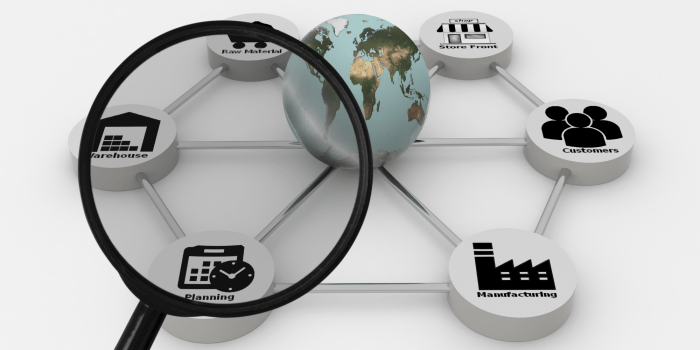
Supply chain transparency, once a niche concern, has exploded into a critical business imperative. Consumers increasingly demand ethical and sustainable practices, pushing companies to open their operations to greater scrutiny. This necessitates a fundamental shift, moving beyond simple compliance to a proactive embrace of transparency throughout the entire supply chain. This exploration delves into the methods, benefits, challenges, and future implications of this transformative shift.
From understanding the core concepts and implementing advanced technologies like blockchain and RFID, to navigating the complexities of stakeholder engagement and risk mitigation, we’ll examine the multifaceted nature of supply chain transparency. The journey will involve exploring ethical sourcing, data collaboration, and the crucial role of robust due diligence in building trust and resilience within the supply chain ecosystem.
Defining Supply Chain Transparency

Supply chain transparency refers to the ability to trace the origin and journey of a product, from raw material sourcing to its final delivery to the consumer. This involves open communication and data sharing across all stages of the supply chain, providing a clear and comprehensive view of the processes, locations, and actors involved. It’s about making the entire supply chain visible and accountable.Supply chain transparency is more than just knowing where a product comes from; it encompasses ethical sourcing, environmental impact assessment, and fair labor practices at each stage.
A truly transparent supply chain enables businesses and consumers to make informed decisions based on a complete understanding of the product’s lifecycle.
Examples of Companies Demonstrating High Levels of Supply Chain Transparency
Several companies are leading the way in supply chain transparency, utilizing various technologies and strategies to provide detailed information about their operations. Patagonia, for instance, publishes detailed information on the origin of its materials, the manufacturing processes, and the social and environmental impacts associated with its products. Similarly, Unilever has invested heavily in traceability initiatives, using blockchain technology to track the origin of its palm oil, combating deforestation and promoting sustainable practices.
These companies demonstrate a commitment to accountability and provide consumers with a level of detail that builds trust and brand loyalty.
Benefits of Increased Supply Chain Transparency for Businesses and Consumers
Increased supply chain transparency offers significant benefits for both businesses and consumers. For businesses, it can lead to improved risk management by identifying potential vulnerabilities and enabling proactive mitigation strategies. Enhanced brand reputation and consumer trust are also significant advantages, as transparency fosters positive brand perception and loyalty. Furthermore, it can improve efficiency and reduce costs by streamlining processes and identifying areas for optimization.
For consumers, transparency provides increased confidence in the products they purchase, ensuring ethical sourcing, fair labor practices, and environmental responsibility. It empowers consumers to make informed choices aligned with their values.
Challenges Associated with Achieving Complete Supply Chain Transparency
While the benefits are clear, achieving complete supply chain transparency presents significant challenges. Data collection and integration across multiple tiers of the supply chain can be complex and costly, particularly when dealing with numerous suppliers and diverse systems. Maintaining data accuracy and security is crucial, requiring robust data management systems and processes. Furthermore, gaining the cooperation of all stakeholders throughout the supply chain is essential, requiring strong relationships and collaborative efforts.
Finally, the complexity of global supply chains, coupled with varying regulations and standards across different regions, adds another layer of difficulty.
Methods for Enhancing Supply Chain Transparency

Enhancing supply chain transparency requires a multi-faceted approach leveraging technology, ethical practices, and robust collaboration. By implementing various strategies, businesses can gain greater visibility into their operations, improve efficiency, and build stronger relationships with their stakeholders. This section explores key methods for achieving this enhanced transparency.
Technologies for Improving Supply Chain Visibility
Several technologies significantly improve the visibility and traceability of products throughout the supply chain. These tools offer real-time data and insights, allowing businesses to monitor their operations more effectively and respond to disruptions promptly.
| Technology | Description | Benefits | Limitations |
|---|---|---|---|
| Blockchain | A decentralized, immutable ledger that records all transactions and movements of goods within the supply chain. | Enhanced traceability, improved security, reduced counterfeiting, increased trust and transparency. | Implementation costs can be high, requires collaboration across the entire supply chain, scalability challenges for very large networks. |
| RFID (Radio-Frequency Identification) | Uses tags attached to products to track their location and movement throughout the supply chain. | Real-time tracking, improved inventory management, reduced theft and loss, efficient warehouse management. | Cost of tags and readers, potential for signal interference, data security concerns. |
| IoT (Internet of Things) | Connects devices and sensors across the supply chain, enabling real-time data collection and analysis. | Improved visibility into inventory levels, environmental conditions, and transportation logistics, predictive maintenance capabilities. | Data security and privacy concerns, high initial investment costs, potential for data overload. |
Ethical Sourcing and Responsible Procurement
Ethical sourcing and responsible procurement practices are fundamental to building transparent supply chains. By prioritizing ethical considerations throughout the procurement process, companies can ensure that their products are made responsibly and sustainably. This includes considering factors such as fair labor practices, environmental sustainability, and human rights. Companies can conduct thorough due diligence on their suppliers and implement robust monitoring mechanisms to verify compliance with ethical standards.
Transparency reports, regularly audited, can provide stakeholders with assurance of the company’s commitment to ethical sourcing.
Data Sharing and Collaboration Among Supply Chain Partners
Effective data sharing and collaboration are crucial for achieving supply chain transparency. Open communication and data exchange between all partners—from raw material suppliers to retailers—enable better visibility into the entire supply chain process. This facilitates proactive problem-solving and enhances responsiveness to market changes. Real-time data sharing allows for quicker identification and resolution of issues, leading to improved efficiency and reduced disruptions.
Data Flow in a Transparent Supply Chain
The following flowchart illustrates the ideal data flow in a transparent supply chain.
Supplier A –(Raw Material Data, Production Data)–> Manufacturer –(Production Data, Quality Control Data)–> Distributor –(Inventory Data, Shipment Data)–> Retailer –(Sales Data, Customer Feedback)–> Consumer
Feedback loops exist between each stage allowing for continuous improvement and enhanced transparency.
Best Practices for Enhancing Supply Chain Transparency
Implementing these best practices helps organizations improve supply chain visibility and build trust with consumers and other stakeholders.
- Establish clear transparency goals and metrics.
- Map the entire supply chain and identify key risk areas.
- Implement robust traceability systems.
- Conduct regular audits and assessments of suppliers.
- Foster open communication and collaboration with suppliers.
- Invest in technology to enhance visibility and data sharing.
- Develop a comprehensive data management strategy.
- Regularly publish transparency reports.
- Continuously improve processes based on data and feedback.
Ultimately, achieving true supply chain transparency requires a concerted effort from all stakeholders. By embracing technological advancements, fostering ethical practices, and promoting open communication, businesses can not only mitigate risks but also cultivate stronger relationships with consumers, investors, and partners. The future of supply chain transparency hinges on a collective commitment to responsible sourcing, sustainable practices, and unwavering accountability.
This increased transparency isn’t just a trend; it’s the foundation for building a more ethical, resilient, and trustworthy global economy.
Popular Questions
What are the legal implications of lacking supply chain transparency?
Depending on the jurisdiction and industry, a lack of transparency can lead to fines, legal action from consumers or NGOs, and reputational damage. Regulations vary widely, but many countries are enacting stricter laws regarding ethical sourcing and environmental impact.
How can small businesses implement supply chain transparency?
Small businesses can start by mapping their supply chain, identifying key suppliers, and engaging in open communication with them. They can also prioritize ethical sourcing practices and utilize readily available tools to improve traceability, even if they can’t afford sophisticated technologies like blockchain.
What is the difference between traceability and transparency?
Traceability focuses on tracking the movement of goods through the supply chain. Transparency, on the other hand, encompasses the broader sharing of information about the entire process, including ethical, social, and environmental impacts.
How can I measure the effectiveness of my supply chain transparency initiatives?
Effectiveness can be measured through key performance indicators (KPIs) such as improved consumer trust, reduced risk of supply chain disruptions, enhanced brand reputation, and increased investor confidence. Regular audits and stakeholder feedback are also crucial.






